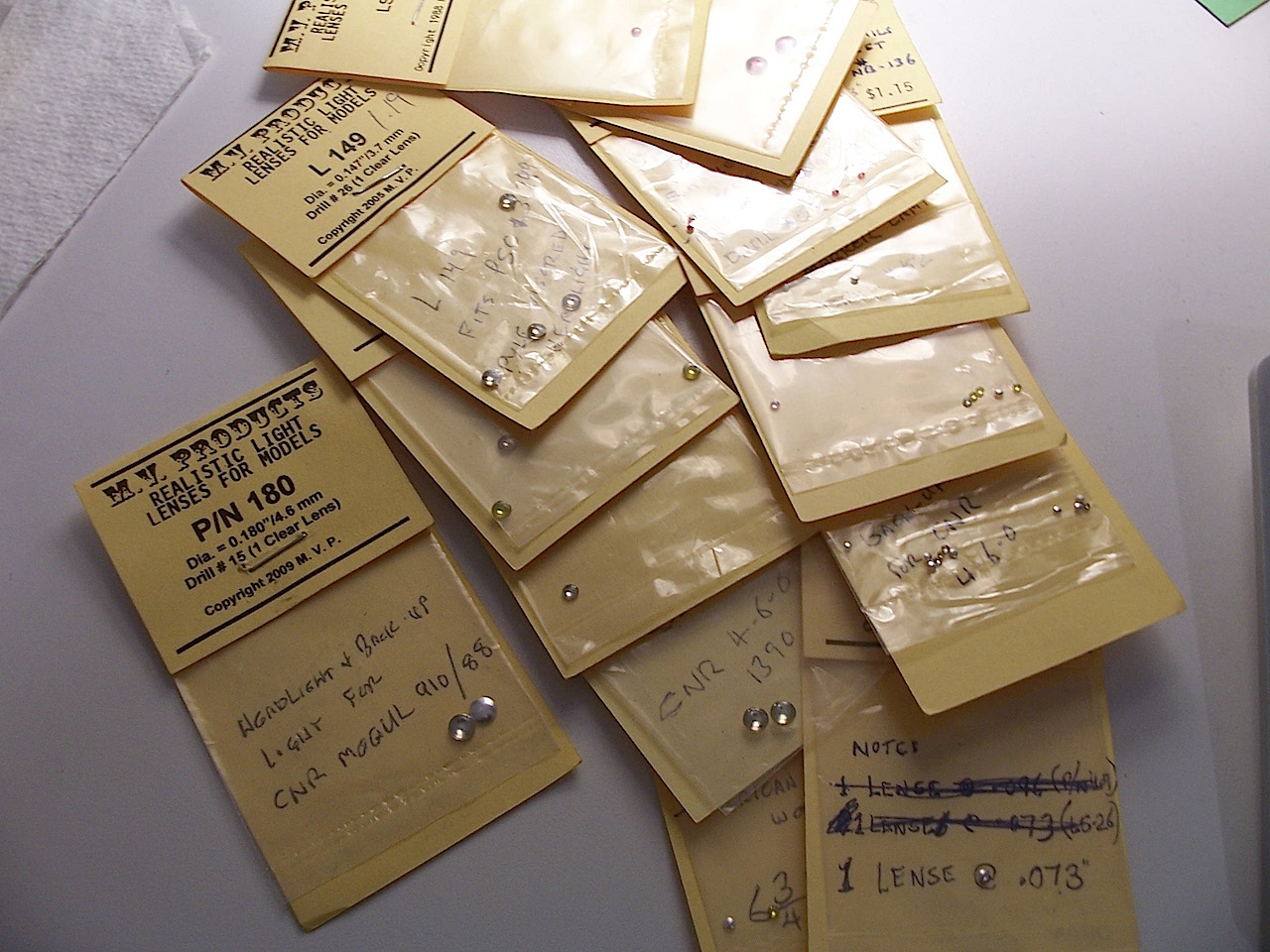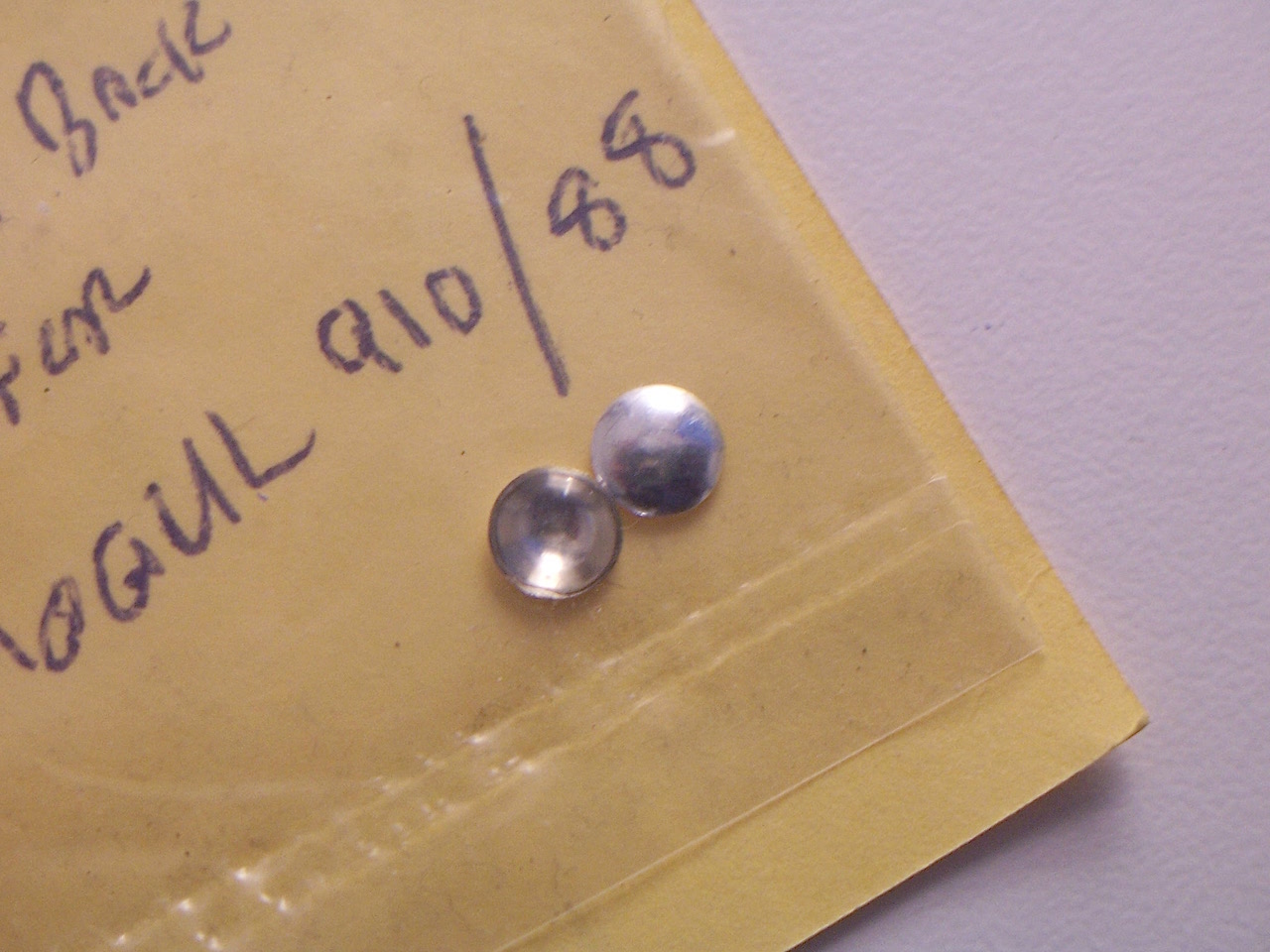09-29-2020, 04:05 PM
The silvering is applied to the outside rear face of each lense. For the ones to which I added LEDs, I used the pointy bit on a draughting compass to make a small indentation on the rear of the lense, then used a suitably-sized bit in a pin vise to drill a shallow hole. In the photos below, the small lenses are roughly .035" thick, while the headlight-sized ones are about .043" thick.
Since the small LEDs emit a fairly directional light, the shallow hole simply allows better contact for gluing than trying to cement it to the rear face of the lense. I don't use LEDs on any of my locos...not a fan of night-time running, when all the effort that's been put into detailing locos and rolling stock or scenery and structures are barely visible.
Here's an illustration showing a range of what might be available...

...while this picture shows two identical lenses...

...the one on the left shows that side which would be visible when installed in a suitable headlight casting, while the one to the right reveals the back-side of the lense, which is only slightly less reflective.
For class lights (non-working) on steam locomotives, I usually paint the areas where the lenses would be using grey paint, as I don't usually use them as class lights. However, if you wished to have unlit class lights, a better choice would be to paint each set of lense receptacles a suitable colour - most likely one white, one red, and one green....as long as they're unlit, it doesn't matter which similar colour-pairs face forward, rearward, or sideways.
To make them look more prototypical, I then mix some clear epoxy, and use the tip of a #11 X-Acto blade to apply an appropriate amount to each location - this is a multi-step process, as each side-facing lense has to be done separately, with the loco laying on its side - if necessary, use something under the boiler to prop it up so that the marker lense area is horizontal while the epoxy sets.
For the front- and rear-facing lenses, the loco can be stood on-end, using whatever support necessary while the epoxy is applied and then allowed to set...in other words, the two forward-facing lenses filled with the loco standing on its cab-end, and the two rearward-facing ones done with the loco standing on its front-end.
If your locos have class lights, and you choose to use the white, green, and red colours, white indicates that the train is an "extra" - not a normally scheduled train.
Green was usually used on passenger trains, and indicated the fact that another section of the same train was following (usually with cars that were an excess part of the train displaying the green markers) On important trains such as the 20th Century Limited or PRR's Broadway, the train might be comprised of several sections, each displaying green class lights, except for the final one.
Red classification lights would be displayed to indicate the rear of a train...f'rinstance, if the train was a block of locomotives only, or if the rear end of the train was a locomotive.
I believe that there are painted class lights on the pilot and tender shown in the thread cited earlier, on the construction of the Pennsy A-5 (those pictures are near the end of the construction portion of the thread). I do think that the painted ones look better than the grey ones...I may have to redo mine, even though I have no intention of illuminating any of them.
Here's a photo showing an MV lense in the headlight, and the grey class lights done with clear epoxy. On this loco, three lenses show on each class-light casting: one pair facing outward to the sides, one pair facing inward (towards each other) and one pair facing forward - when illuminated, the forward-facing ones indicate the train's class

In the event that you can't find suitable MV lenses, especially for headlights, you might be able to create an acceptable alternative by placing a piece of aluminum foil, shiny-side facing out, into the headlight casting, then, with the loco standing on its cab-end, fill it with clear epoxy. I'm not sure if the wrinkles in the foil would be noticeable or not, but if this didn't look acceptable, it shouldn't be too difficult to dig it out before it's fully hardened.
How many headlights do you require, and what are the sizes needed?
Wayne
Since the small LEDs emit a fairly directional light, the shallow hole simply allows better contact for gluing than trying to cement it to the rear face of the lense. I don't use LEDs on any of my locos...not a fan of night-time running, when all the effort that's been put into detailing locos and rolling stock or scenery and structures are barely visible.
Here's an illustration showing a range of what might be available...
...while this picture shows two identical lenses...
...the one on the left shows that side which would be visible when installed in a suitable headlight casting, while the one to the right reveals the back-side of the lense, which is only slightly less reflective.
For class lights (non-working) on steam locomotives, I usually paint the areas where the lenses would be using grey paint, as I don't usually use them as class lights. However, if you wished to have unlit class lights, a better choice would be to paint each set of lense receptacles a suitable colour - most likely one white, one red, and one green....as long as they're unlit, it doesn't matter which similar colour-pairs face forward, rearward, or sideways.
To make them look more prototypical, I then mix some clear epoxy, and use the tip of a #11 X-Acto blade to apply an appropriate amount to each location - this is a multi-step process, as each side-facing lense has to be done separately, with the loco laying on its side - if necessary, use something under the boiler to prop it up so that the marker lense area is horizontal while the epoxy sets.
For the front- and rear-facing lenses, the loco can be stood on-end, using whatever support necessary while the epoxy is applied and then allowed to set...in other words, the two forward-facing lenses filled with the loco standing on its cab-end, and the two rearward-facing ones done with the loco standing on its front-end.
If your locos have class lights, and you choose to use the white, green, and red colours, white indicates that the train is an "extra" - not a normally scheduled train.
Green was usually used on passenger trains, and indicated the fact that another section of the same train was following (usually with cars that were an excess part of the train displaying the green markers) On important trains such as the 20th Century Limited or PRR's Broadway, the train might be comprised of several sections, each displaying green class lights, except for the final one.
Red classification lights would be displayed to indicate the rear of a train...f'rinstance, if the train was a block of locomotives only, or if the rear end of the train was a locomotive.
I believe that there are painted class lights on the pilot and tender shown in the thread cited earlier, on the construction of the Pennsy A-5 (those pictures are near the end of the construction portion of the thread). I do think that the painted ones look better than the grey ones...I may have to redo mine, even though I have no intention of illuminating any of them.

Here's a photo showing an MV lense in the headlight, and the grey class lights done with clear epoxy. On this loco, three lenses show on each class-light casting: one pair facing outward to the sides, one pair facing inward (towards each other) and one pair facing forward - when illuminated, the forward-facing ones indicate the train's class
In the event that you can't find suitable MV lenses, especially for headlights, you might be able to create an acceptable alternative by placing a piece of aluminum foil, shiny-side facing out, into the headlight casting, then, with the loco standing on its cab-end, fill it with clear epoxy. I'm not sure if the wrinkles in the foil would be noticeable or not, but if this didn't look acceptable, it shouldn't be too difficult to dig it out before it's fully hardened.
How many headlights do you require, and what are the sizes needed?
Wayne


